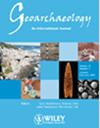硬化土壤结核:古代农业实践的遗迹?
IF 1.4
3区 地球科学
0 ARCHAEOLOGY
引用次数: 0
摘要
识别古代农业系统中的受控火灾对于理解过去的社会是如何管理景观的很重要。尽管最近的历史记录中记录了农业中使用火的情况,燃烧标记物可以在土壤中长期存在,但这是一个复杂的问题,因为燃烧特征普遍存在。在勃艮第(法国)的一片古老森林中进行的考古调查发现了散落在土壤中的几个红色硬结结核。Gallo‐Roman房屋结构和地块是通过光探测和测距测绘识别的,这激发了人们对这些结节性质的理解。通过X射线荧光和X射线衍射(XRD)进行的元素和结构分析,通过将这些特征的成分与现场沉积物进行比较,证实了这些特征的局部来源,热释光测年将样品置于中世纪。研究结果揭示了结核的性质,以及它们与农业实践中使用的受控火灾之间的关系。尽管关于哪些过程会导致结节的形成仍然存在疑问,但通过XRD分析估计的烧制温度似乎与“削皮和烧制”技术中使用的温度一致。本研究提供了关于公元10世纪至12世纪中世纪农业实践的新信息,并展示了过去社会如何利用自然资源和古代“考古”遗迹管理农田的开放和维护。本文章由计算机程序翻译,如有差异,请以英文原文为准。
Indurated soil nodules: A vestige of ancient agricultural practices?
The identification of controlled fires in ancient agricultural systems is important for understanding how past societies managed the landscape. Although the use of fire in agriculture is documented in recent historical records, and combustion markers can persist in soils over a long time scale, this is a complex issue because combustion traits in general are ubiquitous. Archaeopedological surveys undertaken in an ancient forest in Burgundy (France) have led to the recovery of several red indurated nodules scattered in the soils. Gallo‐Roman housing structures and parcels were recognized using light detection and ranging mapping, stimulating questions about the understanding of the nature of these nodules. Elemental and structural analyses by X‐ray fluorescence and X‐ray diffraction (XRD) confirmed the local origin of these features by comparing their composition with on‐site sediments, and thermoluminescence dating placed the samples in the Medieval period. The results cast light on the nature of the nodules and how they can be related to controlled fires used in agricultural practices. Even though questions remain about which processes lead to the formation of the nodules, the firing temperature estimated via XRD analysis seems to be in agreement with that used in the “paring‐and‐burning” technique. The present study provides new information about medieval agriculture practices from the 10th to the 12th centuries CE and shows how past societies managed the opening and maintenance of agricultural fields using natural resources and “archaeological” remains from the antique period.
求助全文
通过发布文献求助,成功后即可免费获取论文全文。
去求助
来源期刊

Geoarchaeology-An International Journal
地学-地球科学综合
CiteScore
3.60
自引率
5.90%
发文量
51
审稿时长
>12 weeks
期刊介绍:
Geoarchaeology is an interdisciplinary journal published six times per year (in January, March, May, July, September and November). It presents the results of original research at the methodological and theoretical interface between archaeology and the geosciences and includes within its scope: interdisciplinary work focusing on understanding archaeological sites, their environmental context, and particularly site formation processes and how the analysis of sedimentary records can enhance our understanding of human activity in Quaternary environments. Manuscripts should examine the interrelationship between archaeology and the various disciplines within Quaternary science and the Earth Sciences more generally, including, for example: geology, geography, geomorphology, pedology, climatology, oceanography, geochemistry, geochronology, and geophysics. We also welcome papers that deal with the biological record of past human activity through the analysis of faunal and botanical remains and palaeoecological reconstructions that shed light on past human-environment interactions. The journal also welcomes manuscripts concerning the examination and geological context of human fossil remains as well as papers that employ analytical techniques to advance understanding of the composition and origin or material culture such as, for example, ceramics, metals, lithics, building stones, plasters, and cements. Such composition and provenance studies should be strongly grounded in their geological context through, for example, the systematic analysis of potential source materials.
 求助内容:
求助内容: 应助结果提醒方式:
应助结果提醒方式:


